This post may contain affiliate links. Please read our disclosure policy.
Baklava is a rich, decadent dessert recipe made of layers of flaky filo dough, filled with chopped roasted cinnamon walnuts, and sweetened with a sticky honey sauce. This recipe is not only impressive, but it is extremely easy to make.
Scroll down for tons of step-by-step photos and the full detailed recipe.
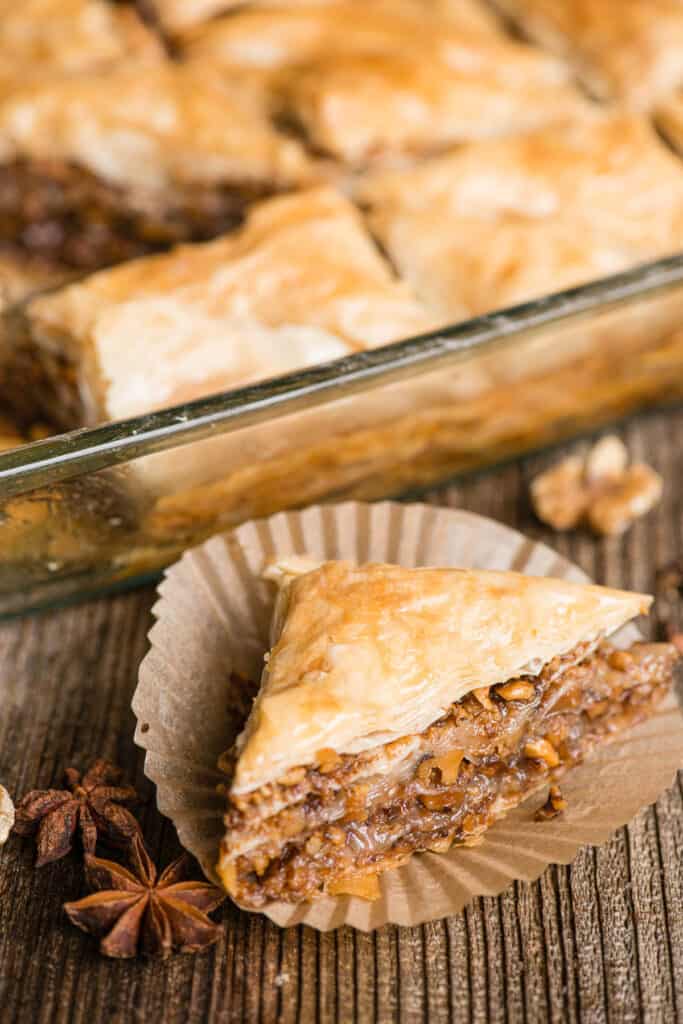
Why you’ll love this recipe:
I grew up eating baklava and it’s truly one of my favorite sweet treats.
- Easy to make: If you’ve ever enjoyed this sweet treat, chances are you bought it at a restaurant, bakery, or store. It is, however, actually extremely easy to make! Working with phyllo dough can be intimidating because it will dry out quickly, but as long as you follow the recipe steps and tips below, this recipe will turn out perfectly.
- Super sweet: This is one of those desserts where a little goes a long way. The honey and sugar perfectly balance the salty buttery flaky pastry dough and crunchy nuts. This recipe gives you a little bit of everything: sweet, salty, crunchy, chewy. Serve it with a strong cup of coffee for the perfect treat!
- Customizable: This recipe uses walnuts, but next time I think I’ll make pistachio baklava. There are so many variations you can do to vary how this easy baklava recipe turns out!
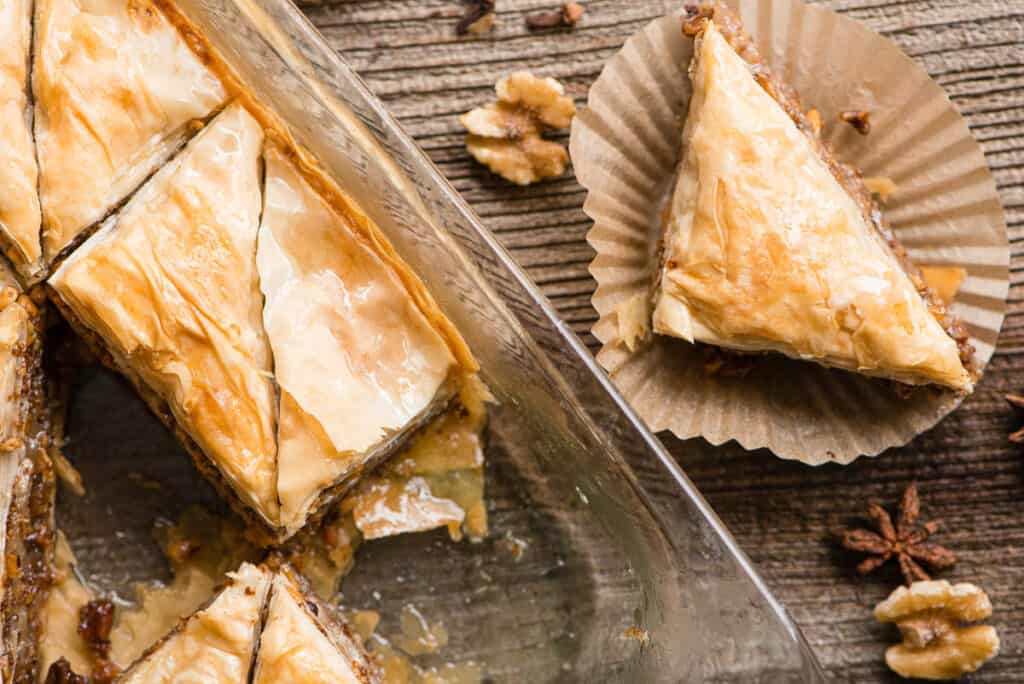
Ingredients needed:
Exact quantities are listed in the recipe card below, but here is a summary.
- Syrup: The syrup is made of equal parts water and sugar along with honey and vanilla. I always use raw honey and pure vanilla extract.
- Dough: Phyllo dough is what makes up the thin crunchy layers. You can buy this in the freezer section of your grocery store or you can make your own.
- Nut filling: Walnuts, butter and cinnamon make up the filling. Using a high quality butter makes all the difference.
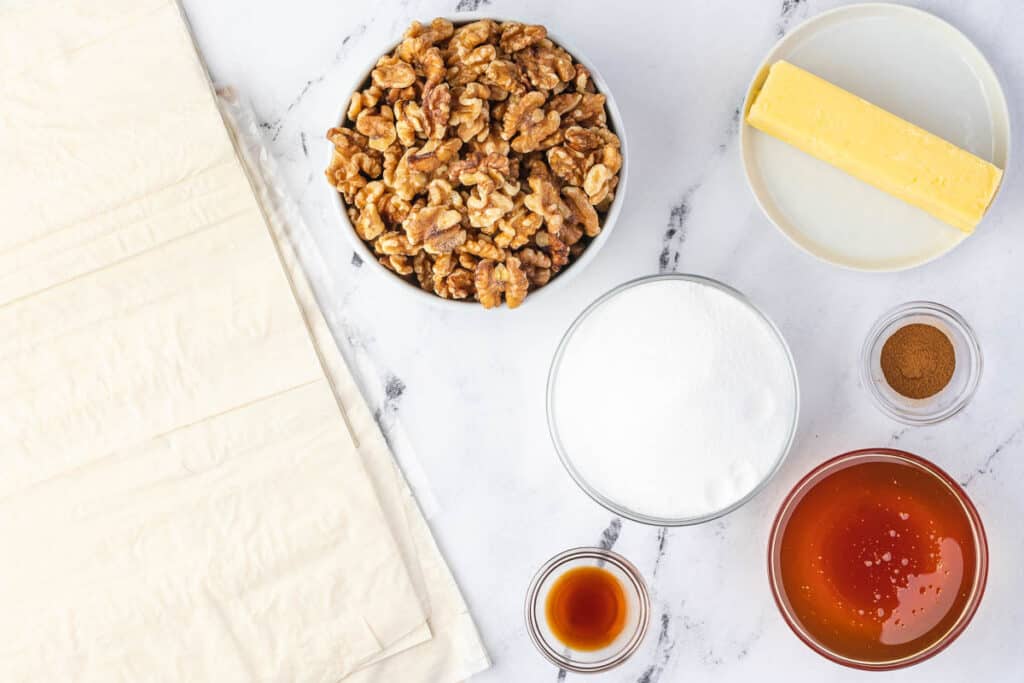
How to make this baklava recipe:
Detailed step by step instructions are listed in the recipe card below, but here is a summary.
Step 1: Make the syrup
Add all of the syrup ingredients to a pan and heat until it comes to a boil while stirring constantly to dissolve the sugar. Then, reduce the heat to maintain a simmer and allow to cook for about a half hour. Transfer to a measuring cup and allow to cool.
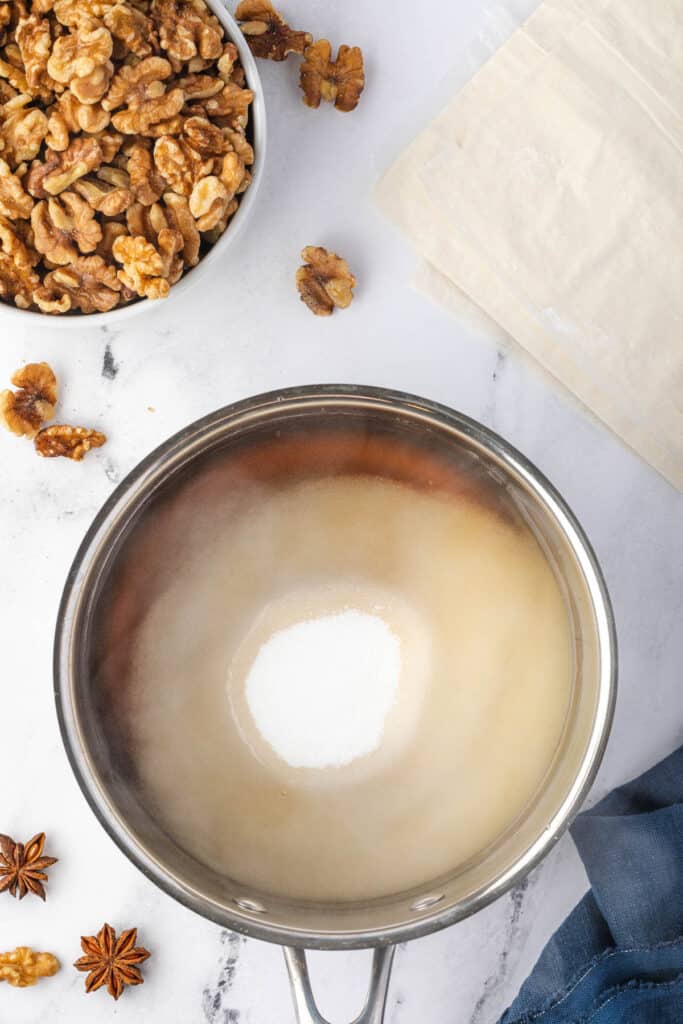
sugar, honey, water, cinnamon 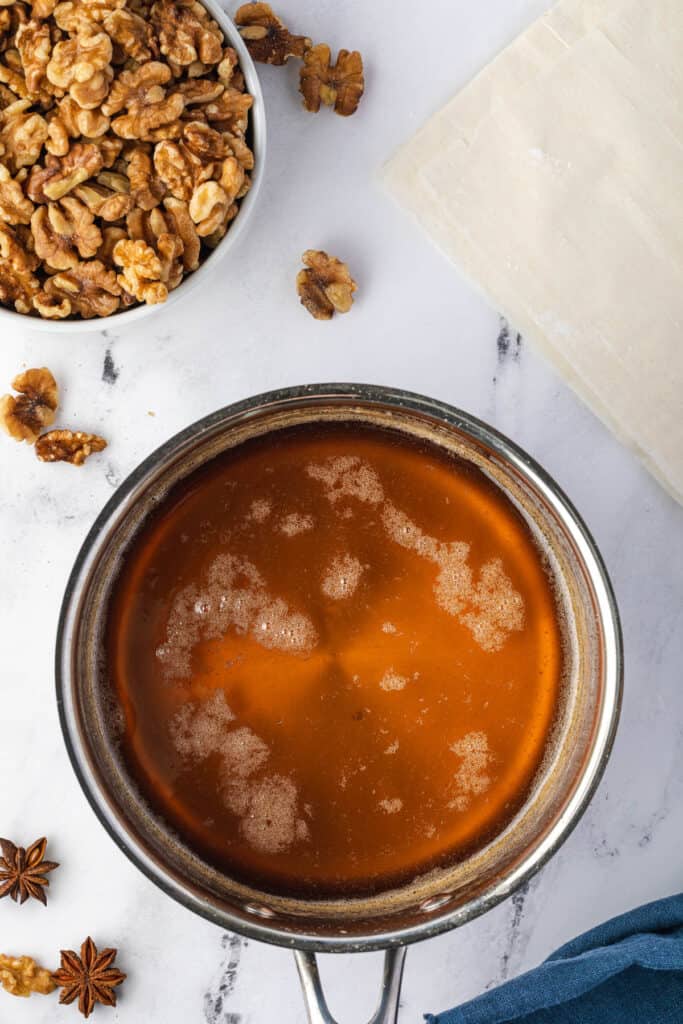
heat to make syrup
Step 2: Toast the nuts
I like to leave the raw walnuts whole while I toast them in the oven and then I run them through the food processor to chop them into tiny pieces. At this point you’ll combine with the cinnamon and set them aside.

place raw walnuts on baking sheet 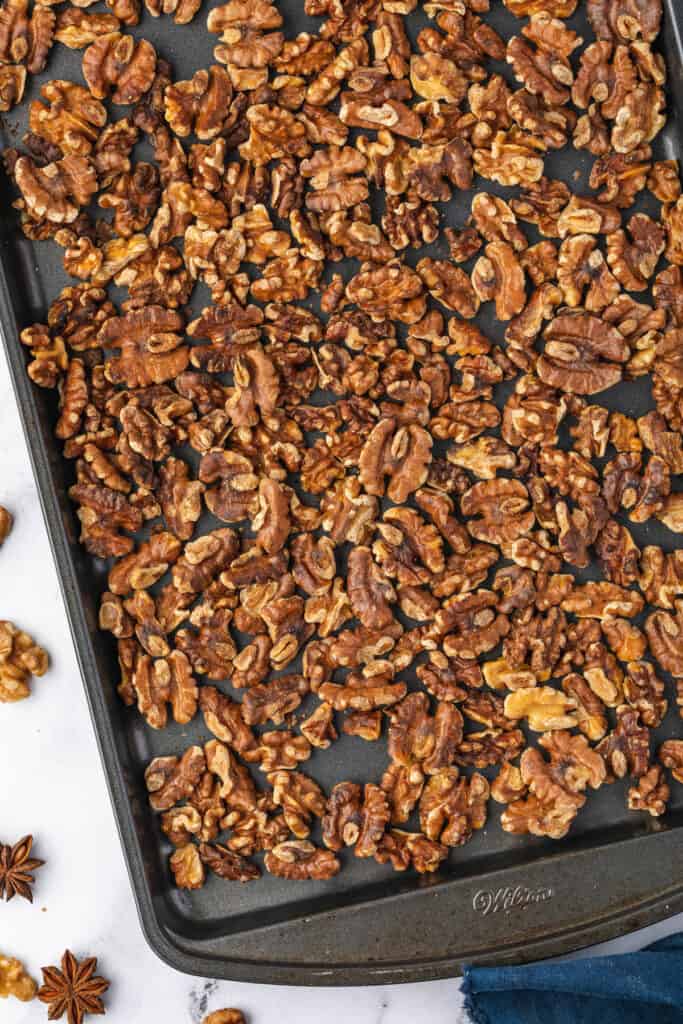
toast in oven 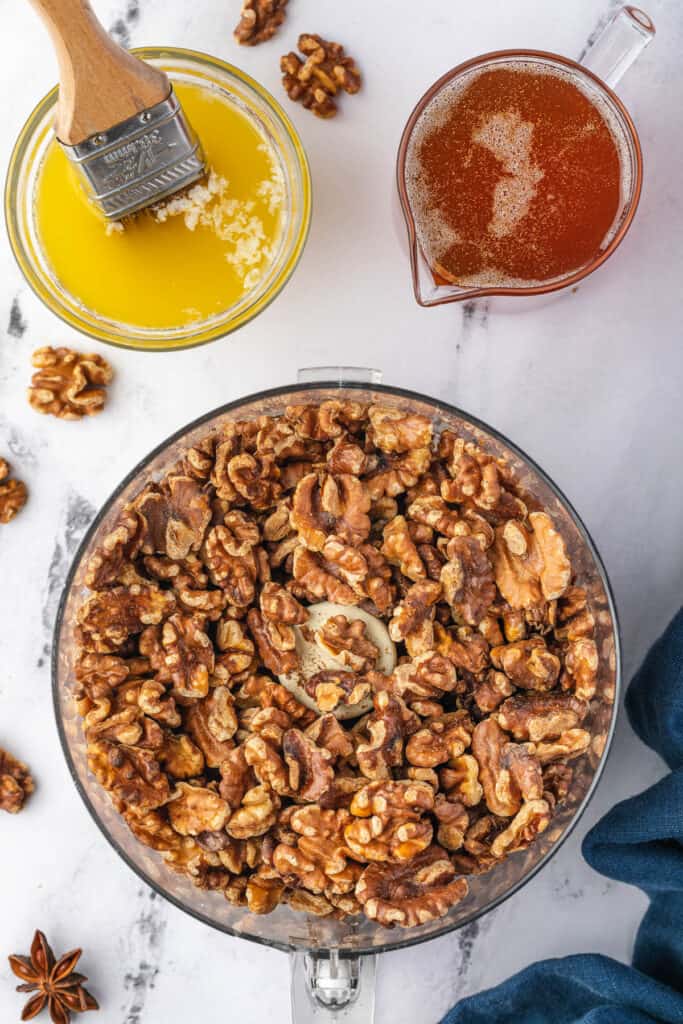
chop into smaller pieces 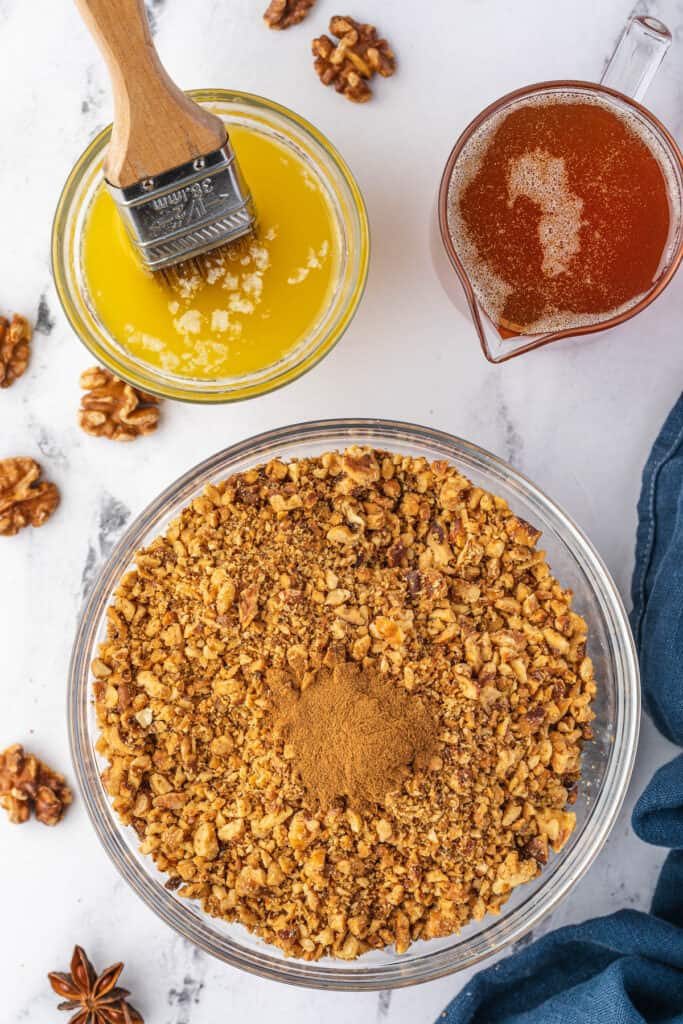
combine with cinnamon
Step 3: Assemble the baklava
Now it’s time to assemble the baklava. Phyllo dough dries out almost instantly so it’s extremely important to keep the unused sheets with a damp (not wet) towel.
- Paint the bottom of your baking dish with butter.
- Lay down two sheets of dough, paint with a thin layer of butter, more dough, more butter, and so on. Do this until you have 8 sheets of dough on the bottom.
- Continue the same process, but this time you’ll be adding a few tablespoons of the cinnamon walnut pieces in between.
- Do this until you have 8 remaining sheets of dough for the top.
- The top follows the same dough/butter layering as the bottom.
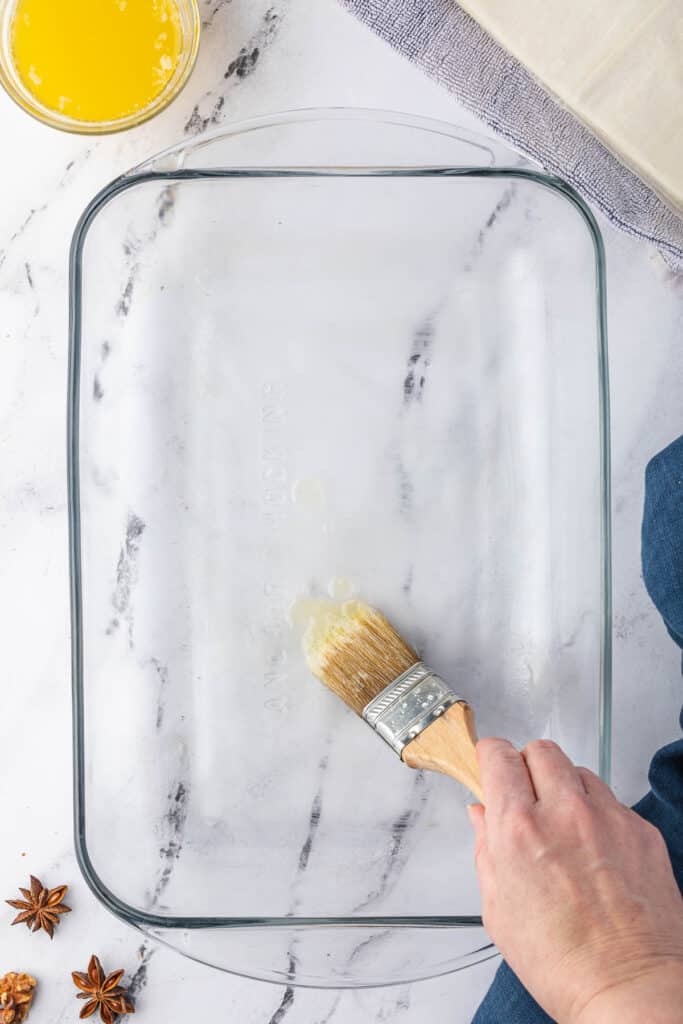
paint melted butter onto dish 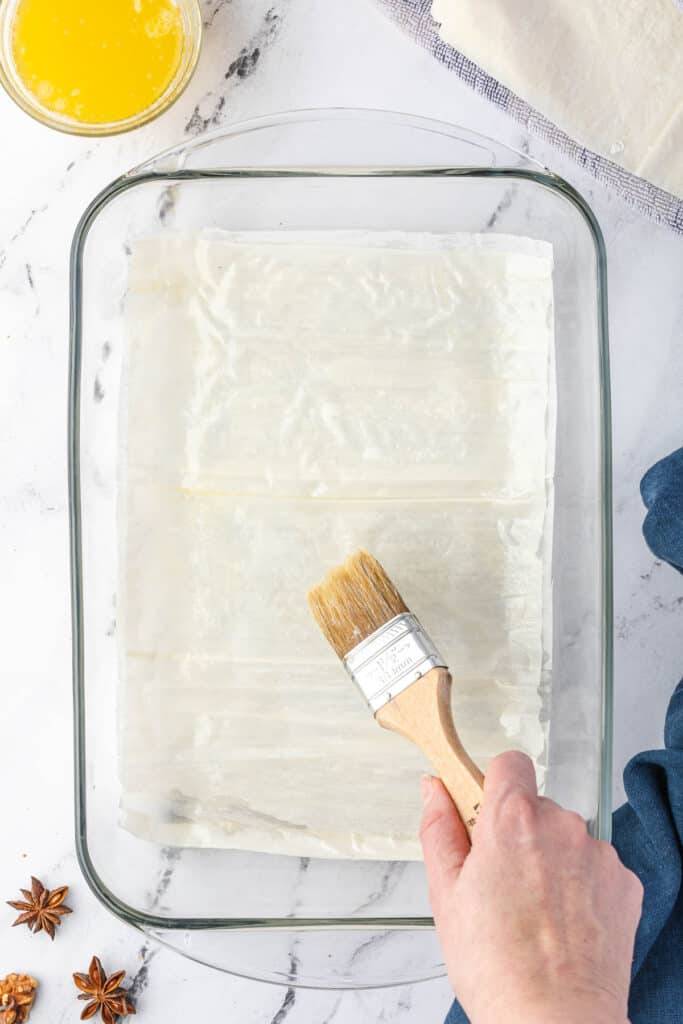
layer butter in between layers 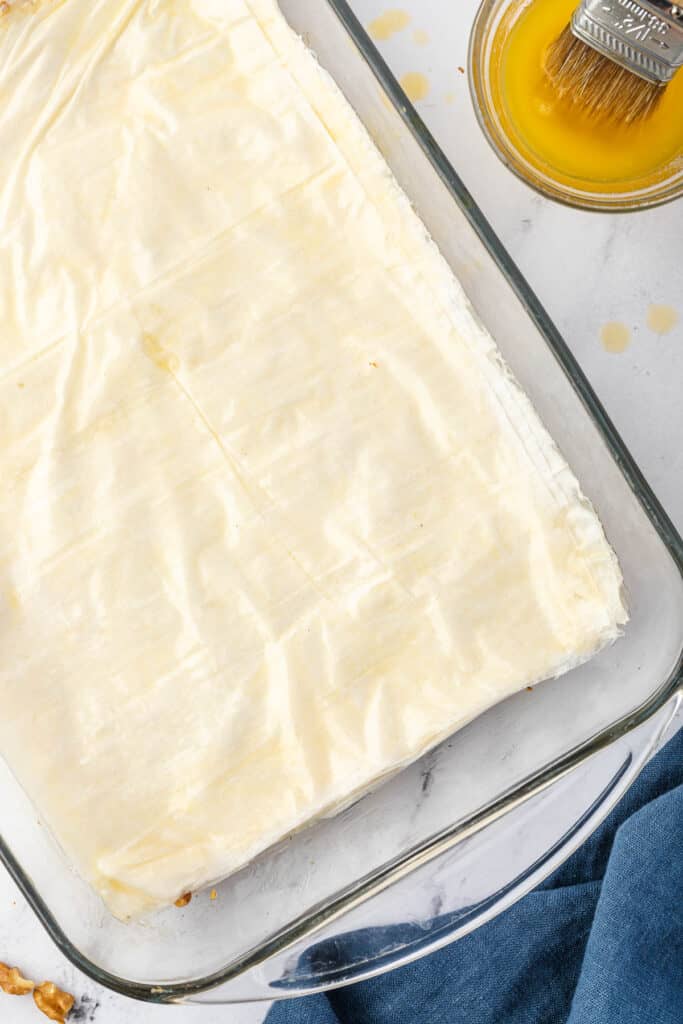
create pastry base 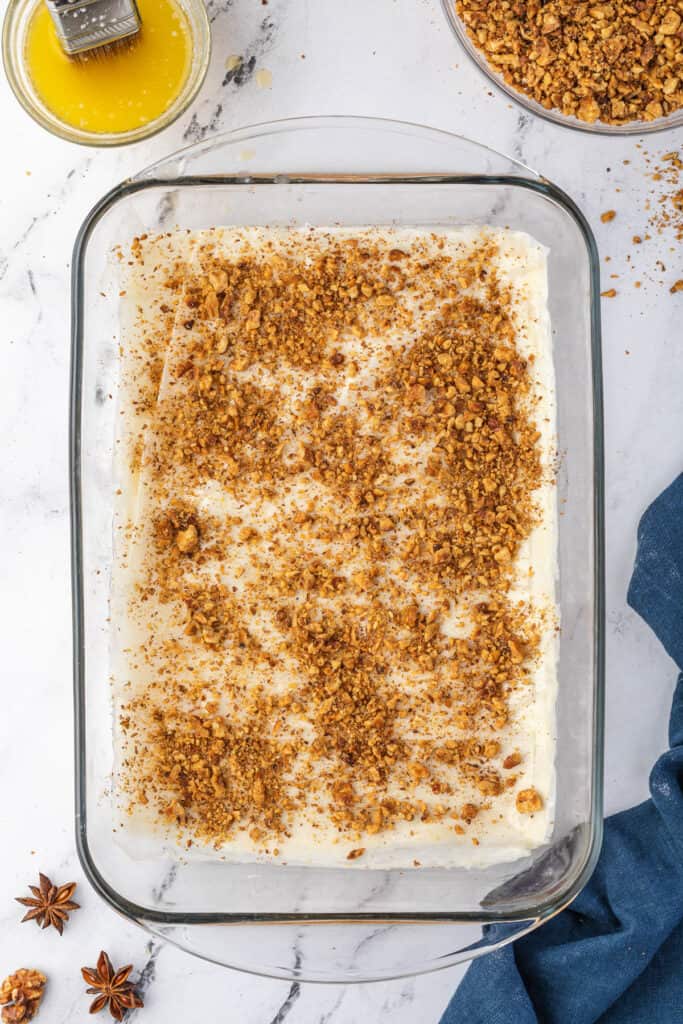
add cinnamon nuts 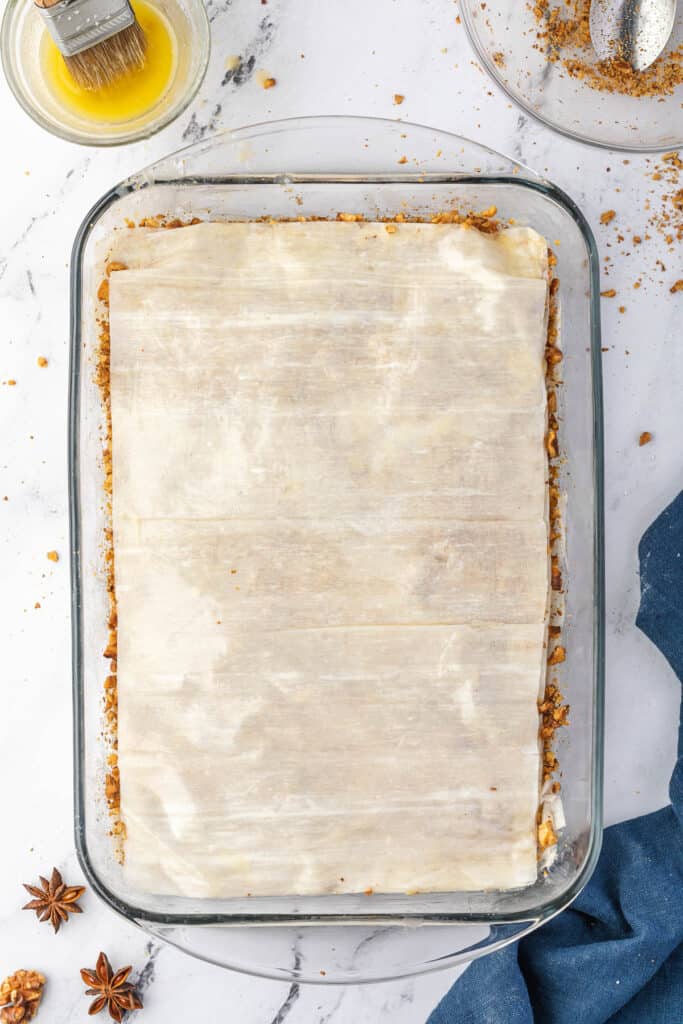
layer dough and nuts 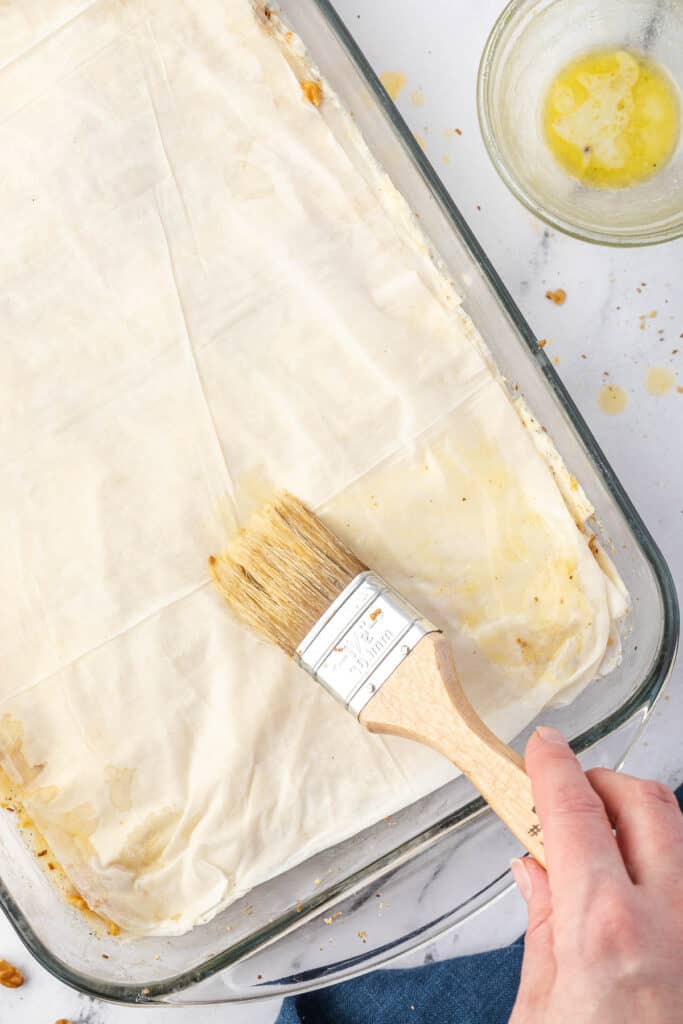
create buttered layered top
Step 4: Cut pieces
Here’s the trick with great baklava: once everything is assembled, cut the pieces but do not cut all the way through the bottom layer. This will allow you to have beautiful pieces once it’s cooked, but the solid bottom layer will keep the syrup in the middle and not all over the bottom of the pan.
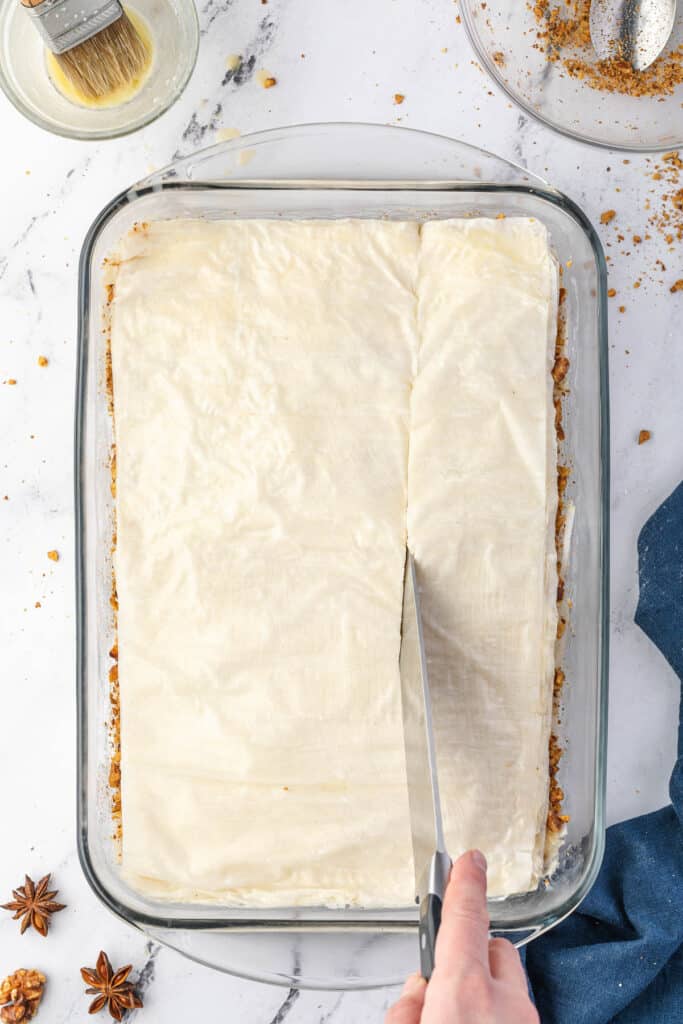
slice into pieces 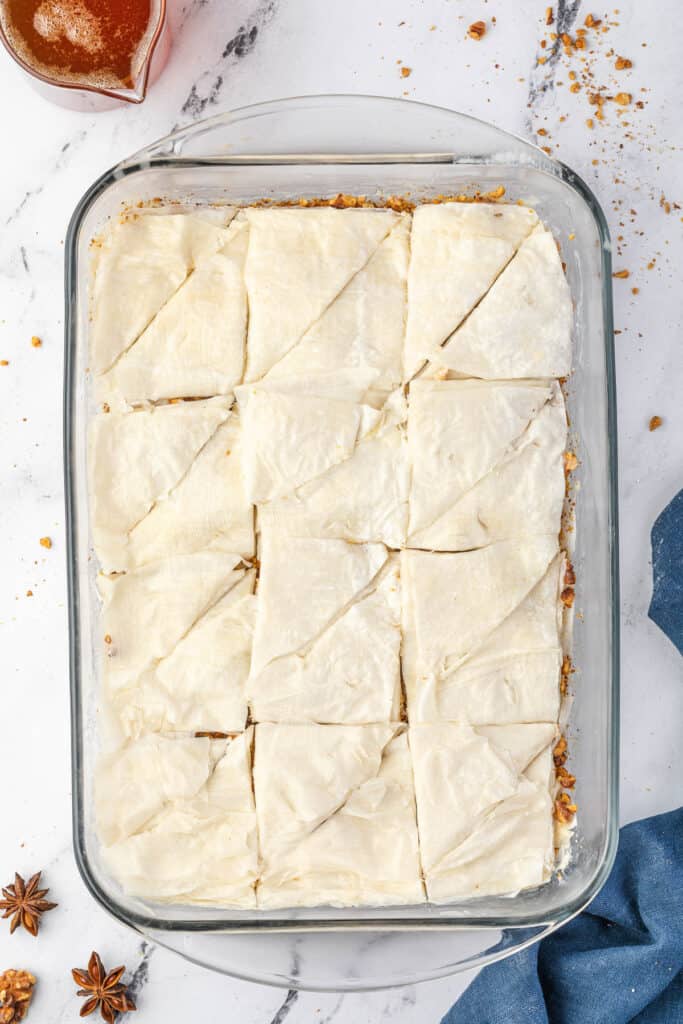
do not cut through bottom layers
Step 5: Bake and add syrup
Bake until golden brown and then immediately pour the syrup over the top. This is the best part!
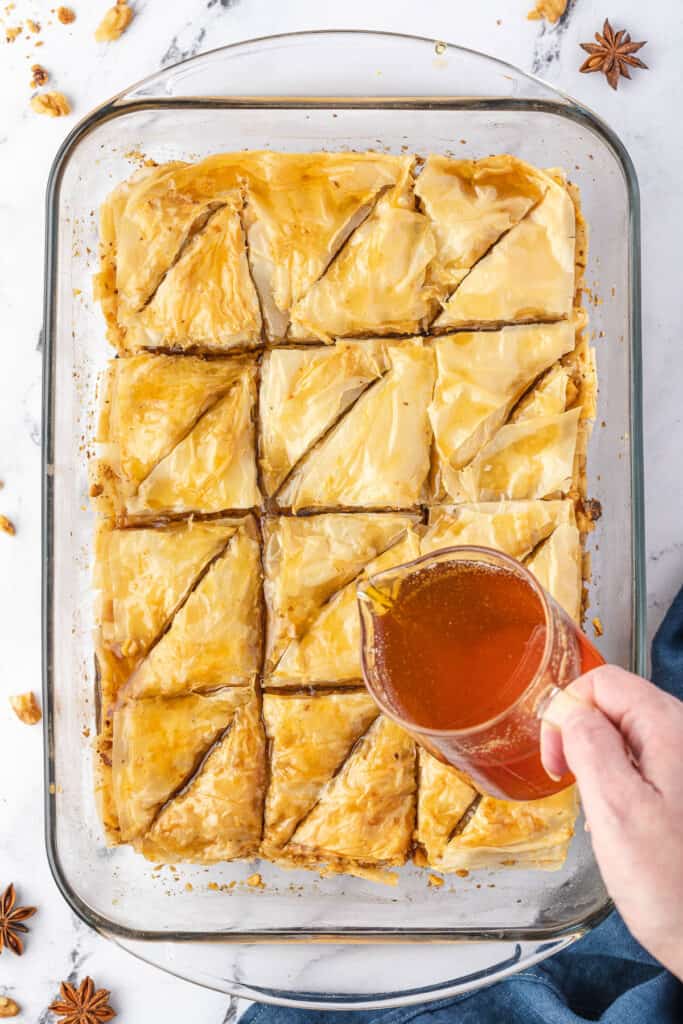
remove baklava from oven 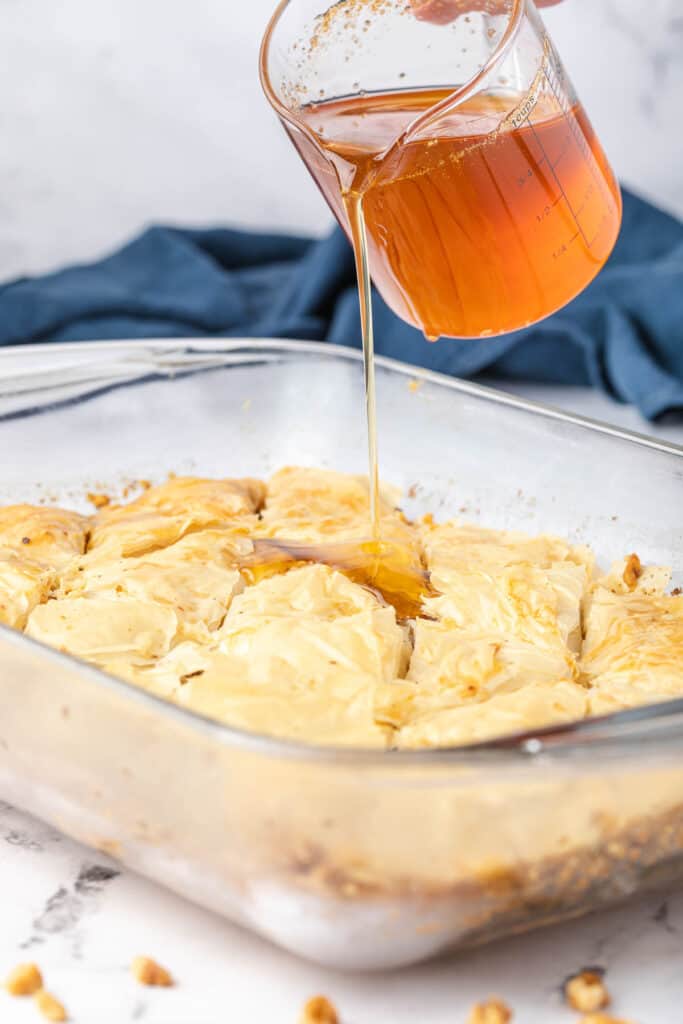
immediately add syrup 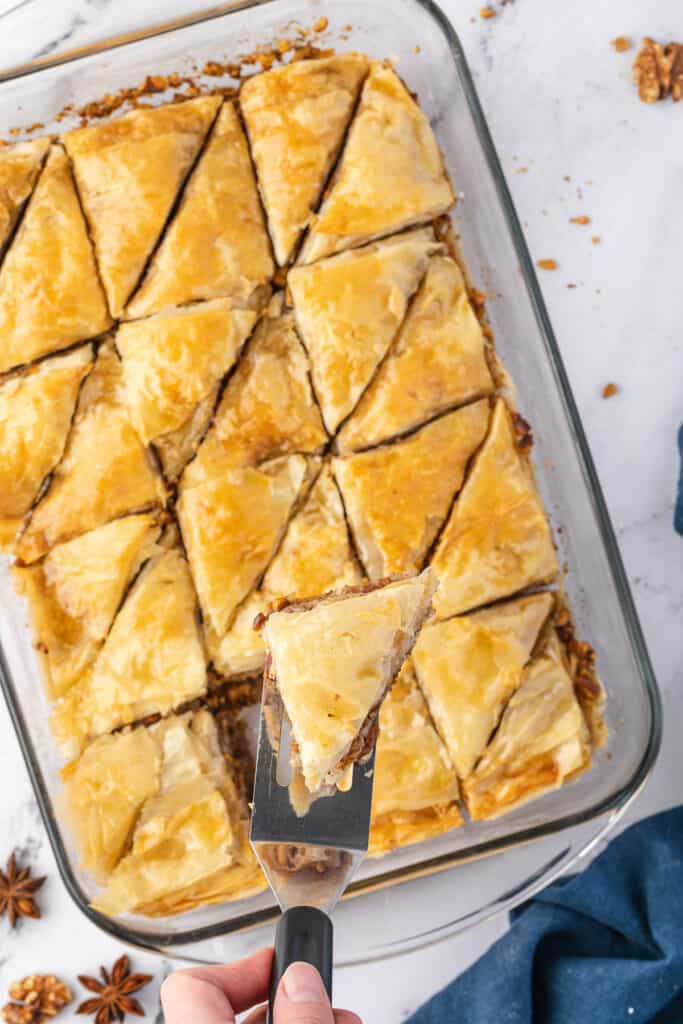
allow to cool 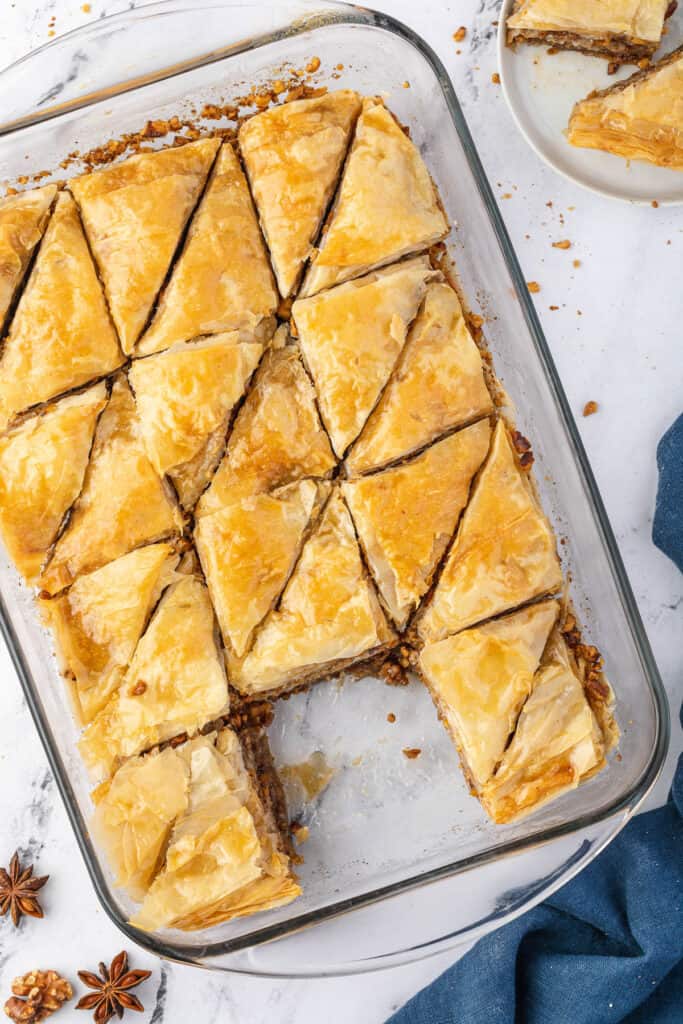
serve and enjoy
Recipe tips for perfect results:
- Working with Phyllo Dough: Ensure the dough has fully thawed before using, however do not open the package until you are ready to bake the baklava. You must always keep it moist (not wet), otherwise it will dry out.
- Variations: The easiest way to alter this recipe and to make it your own is to substitute the type of nuts used. Other than walnuts, the most popular choice is to use pistachios.
- Storage: Baklava is best enjoyed fresh on the day it is made, however it will still taste wonderful for several days. To store, do not cover tightly as air flow is needed to prevent the baklava from getting soggy. Instead, loosely cover with a lid or, my preferred method, a kitchen towel. This will allow air flow but will also keep anything from touching the baklava.
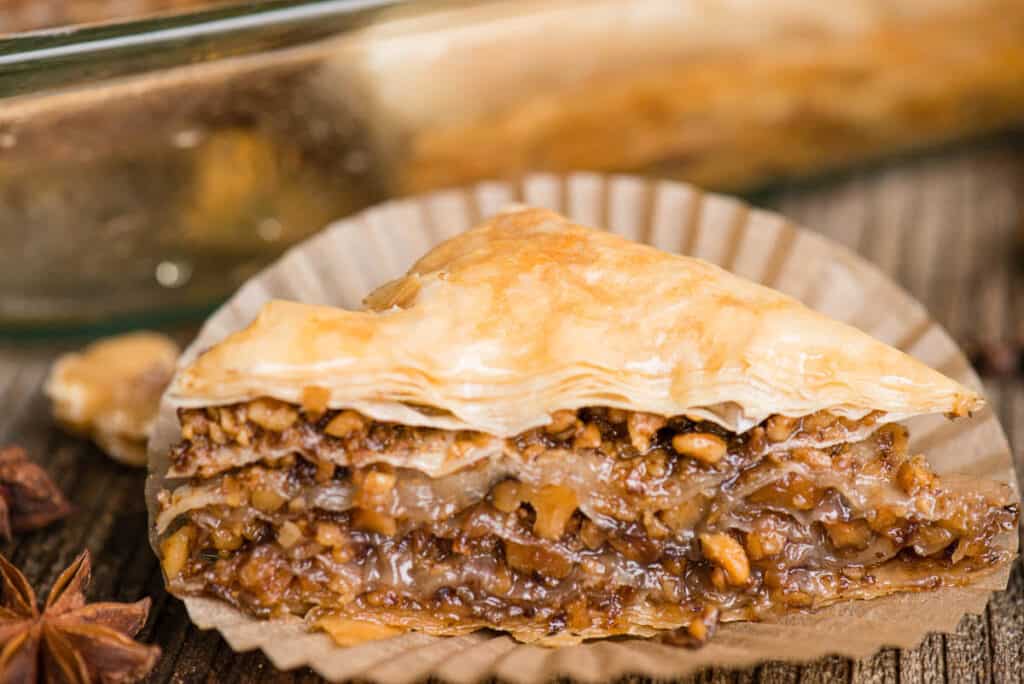
FAQs:
- What is baklava? This is simply a pastry dessert layered with phyllo, or filo, dough, chopped nuts, and a sweet syrup.
- What does it taste like? Because of the honey, baklava is insanely sweet. The outside is crisp, and the dessert has delicate layers of golden brown phyllo dough layered with cinnamon spiced nuts. Since the layers have been lathered in melted butter, they literally crumble and melt away in your mouth.
- Recipe origins: It is believed that baklava originated in Turkey and is now a popular dessert across the entire Greek and Middle Eastern regions.
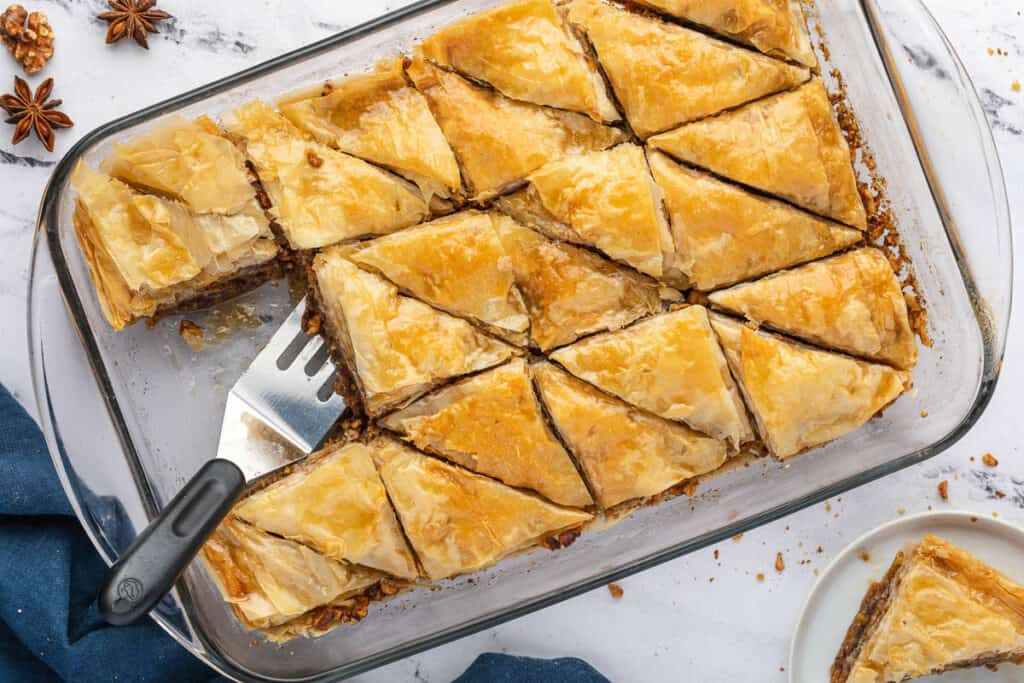
Pin this now to save it for later
Pin ItBaklava Recipe
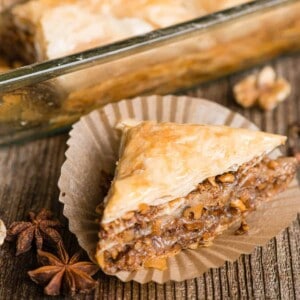
Ingredients
Syrup:
- 1 1/2 cups water
- 1 1/2 cups granulated sugar
- 3/4 cup honey
- 2 teaspoons vanilla extract
Instructions
Prep work:
- Make syrup: Combine 1 1/2 cups water, 1 1/2 cups granulated sugar, 3/4 cup honey and 2 teaspoons vanilla extract in a medium sized saucepan. Bring to a boil, stir to dissolve sugar, and then reduce heat as low as possible so that it can still maintain a gentle simmer. Maintain simmer and cook uncovered for about 25-30 minutes. Transfer to a glass measuring cup and allow to fully cool.
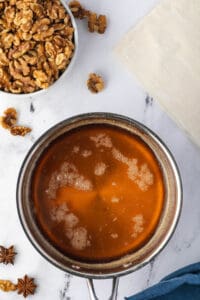
- Preheat oven to 325° F.
- Toast nuts: Spread 1 pound walnuts onto baking sheet into single layer. Toast in preheated oven for 15-20 minutes, stirring occasionally to prevent burning. Remove from oven and allow to fully cool. Use a large knife to chop them into small pieces or pulse in food processor (my preferred method). Combine with 1 teaspoon cinnamon and set aside.

To assemble and bake baklava:
- Prepare dough: Unroll 16 ounces phyllo dough. Cut sheets so that they fit perfectly in a 9×13-inch baking dish. Dampen and ring out two clean kitchen towels or large sheets of paper towels and place them above and below the phyllo dough. Keep the dough covered at all times with moist cloths so that it doesn't dry out.
- Create base: Using a pastry brush, paint the bottom of the baking dish with 1/2 cup salted butter. Add two sheets of dough, spread a thin layer of butter on top, then repeat with two more sheets of dough, butter, dough, butter, etc. until you have a base layer of 8 sheets.
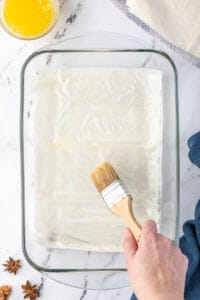
- Add nuts and layer: Now, you will lay down a thin layer of melted butter, 2-3 tablespoons of the crushed toasted cinnamon nuts, and top with two sheets of dough. Repeat this butter/nut/dough layering process until you are left with 8 remaining sheets of dough.
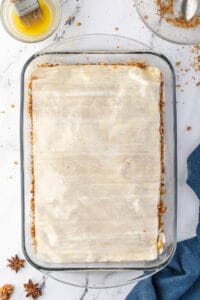
- Finish layering: The top layer will consist of two sheets of dough, butter, two sheets of dough, butter, and so on. If you run out of butter, you may need to melt more, but the goal is to have a very thin layer every time you add it and I like to paint the top with the last bit of butter.
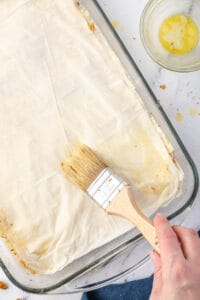
- Cut servings: Cut the baklava prior to baking with a very sharp knife. Cut through the top layer but do not go all the way through to the bottom. You want the bottom layer to remain intact. I prefer triangles so I cut rectangles first and then cut across on a diagonal.
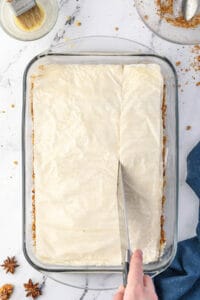
- Bake: Cook baklava in preheated 325°F oven for about 50 minutes until the top is crisp and golden.
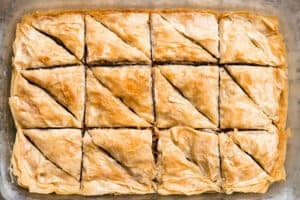
- Add syrup: As soon as you remove baked baklava from the oven, pour the cooled syrup over the entire top, allowing it to sink down through all the layers. This is why you didn't cut all the way through. By leaving that bottom layer whole, it won't make your baklava soggy. Allow everything to cool.
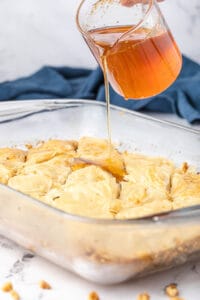
- Serve and enjoy: Best if served same day, but can be stored for several days at room temperature. I prefer to cover loosely with a kitchen towel to prevent anything from touching it because airflow is needed to prevent the baklava from getting soggy.
Notes
Nutrition
Nutrition information is automatically calculated, so should only be used as an approximation.
This recipe was originally published in August 2019 and has been updated with helpful information, ingredient and process photos, as well as recipe tips. Don’t worry – the recipe hasn’t changed!
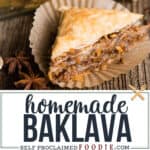

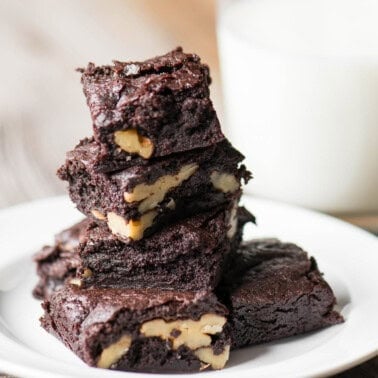
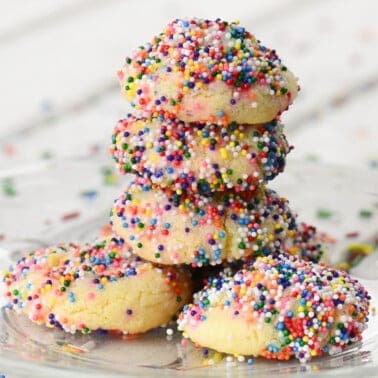
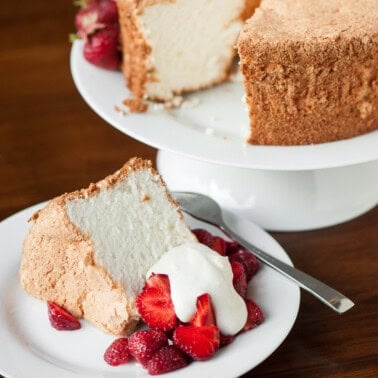
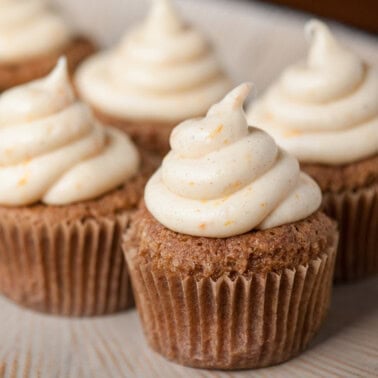









As a Turkish man and a long time bakery owner in Istanbul I can easily say this is not a baklava. There’s no cinnamon nor honey on baklava. Also dough has zero salt. This is what I can cal baklava looking pastry.
I have no doubt what you make is authentic. Like all of my recipes, my versions have been American-ized and I put my personalized spin on them. I agree that Turkish baklava is the best, but there are many variations out there!
This is the best baklava! I have made it at least 5 times in the last 6 months and it is perfect every time. The new favorite request from my family for celebratory dinners! Thanks.
I followed the instructions for the syrup but its still runny. What did I do wrong?
The sugar should still be runny. It’s okay. Some of the water evaporates while it simmers but not all. It should sink in and absorb. How did it turn out in the end?
This is my 2nd time making this recipe. Better than the first time I made it. Definitely a Family Favorite. Thanks for the recipe.
I’m diabetic, but this sounds delicious, any chance you could use a sugar substitute? Being a diabetic is a real drag, but sometimes a little treat can be a real boost.
Hi Shirley, I love offering substitutions, but this is one of those recipes I wouldn’t change. I’m sorry!
Okay, this looks seriously good! Can’t wait to try it!
What a delicious dessert; a restaurant worthy recipe, indeed! Delish!
This is a family favorite! Thanks for a great recipe!
Baklava is seriously so good. This is a great recipe!
This looks so delicious! I’ve never considered making baklava myself, but you convinced me! I plan to tackle it this weekend.